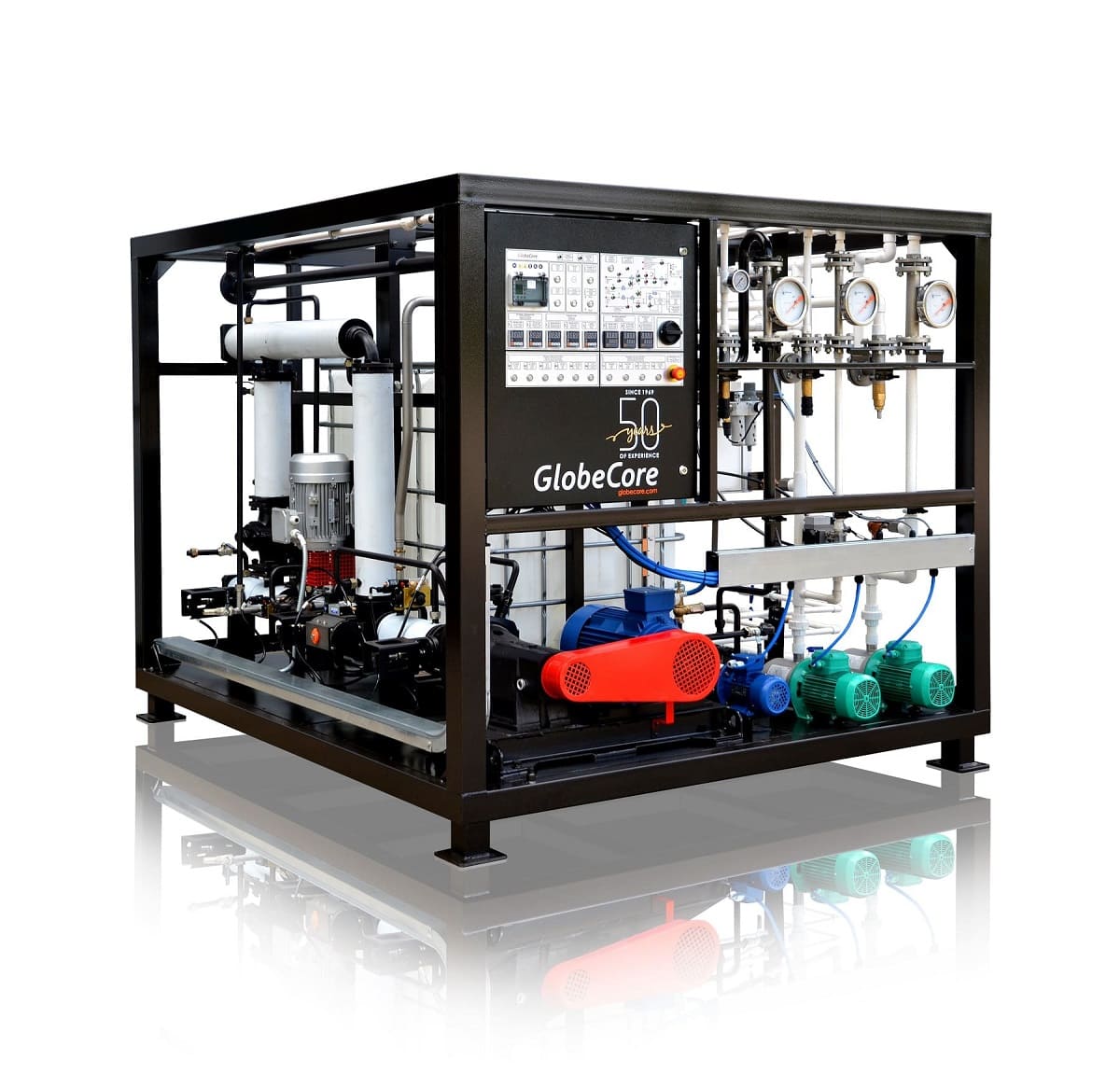Literature contains much information on using bitumen emulsions in road construction.
Damaged bitumen surfaces
Surface damage. The beginning of surface damage is easily visible after rain. The first indications of surface destruction can be identified by finding wet spots on an otherwise dry surface. These may be caused by insufficient binder content in the surface, low surface quality due to poor removal of dust and dirt from the base layer, as well as actual surface damage due to vehicle braking or formation of hair-thin cracks which form in slightly subzero temperatures. Most damage occurs in the winter months due to adverse weather. This makes preventive measures in autumn and restoration in spring quite important..
First of all, the spot to be repaired must be cleaned to remove dirt. Then a layer of unstable bitumen emulsion is applied. The emulsion coat should cover the surface extending to 15 cm beyond the edge of the damaged spot. Fine stone material (1-3 mm grain size) or 0-2 mm sand is applied over the emulsion, then the patch is compacted.
When repairing surface damage, a small amount of binding and mineral materials should be used to keep the road’s profile, which is one of the most important conditions to ensure road durability. Uneven patches can cause further destruction of the surface. The low viscosity of bitumen emulsion makes it possible apply a very thin film of bitumen.
Depressions
Depressions in the surface of the road are usually caused by uneven compaction of the base layers. To prevent more serious damage, the profile of the road must be restored as soon as possible. The repair process is similar to the one described above. To fill a depression, the stop is cleaned and covered by a thin layer of unstable emulsion, then with a layer of mineral material with grain sizes 2-5 or 5-8 mm. The spot is then evenly compacted. The mineral material must be placed even with the surface of the road. Deeper depressions are filled with stone material of larger grain size, then covered with ground material with 5-7 mm grain size. With such a small thickness of the coating, emulsion settles very quickly, so it is recommended to repeat application of this coating in the same sequence; this is especially important in the case of deep depressions. The pores of the coating is then coated with bitumen. The final stage is applying another layer of unstable emulsion (0.8 kg/m2) and sand (0-2 mm, 3-5 kg per m2). Light compaction finishes the job.
Potholes
The method above allows to repair potholes effectively, but it is impossible to entirely eliminate their repeated formation. The repair process is similar to the above.
Just as with any other works, the surface must first be thoroughly cleaned. Water should be removed from the pothole, however, the area must not be completely dry. If any dirt remains, it will hinder the formation of strong bond between the base surface and the new coat.
Impregnation methods
Flat potholes with the depth up to 3 cm are filled with enough unstable emulsion to bind the mineral material. The pothole is then filled with 5-8 mm stones and compacted manually until emulsion can be seen on the surface. Then the spot is covered with 2-5 or 1-3 mm stone material. If the amount of emulsion originally applied is not sufficient, more can be added before applying that stone layer.
Potholes deeper than 3 cm are filled in layers. First the pothole and its edges are covered with a thin layer of emulsion, filled with 12-18 mm stones, filled with emulsion and compacted. The second layer contains smaller grain stones, e.g. 5-12 mm, with more emulsion impregnation and compaction. The process ends with a top layer of 1-3 mm or 2-5 mm stones, emulsion and compaction.
Deep potholes are filled with gravel as a filler. If the pothole is large, special bitumen sprayers can be used for speed and efficiency.
Cracks
Cracks often form in dense bitumen coatings, sheet asphalt and cast asphalt. In some cases the cause of the cracking is insufficient base size, in other cases the cracks appear over concrete base. The reason for cracking is heat expansion and compression of the base concrete plate. Such cracks are mostly distributed across the surface; they can be repaired by application of emulsion. The cracks are purged with compressed air and thoroughly treated with stable emulsion. The bitumen suspension is prepared by mixing three parts of 0-3 mm sand, one part filler and one part highly stable emulsion. In this process the suspension solidifies on the surface, but remains liquid longed inside the crack, giving enough time to fill the crack with the binding material.
Pavement ripping
Another bitumen emulsion application is restoration of pavement after removing it for cable or pipe laying. Such works require thorough compaction of the ground in the trenches, so that the consequent settling is minimized. Pavement restoration begins after compaction. It is recommended to first apply a layer of unstable emulsion, then add the corresponding mineral material and compact it. Even with the most vigorous and thorough compaction after filling the trench, some settling is inevitable. The mix of bitumen emulsion and mineral materials also yields somewhat, so after a certain time, the road profile must again be smoothed by applying another layer of emulsion and stone.
Pavement repairs
Older pavements, designed for lower intensity traffic, become uneven, making not only vehicular, but pedestrian traffic difficult. Small potholes can be mended by two surface layer treatments. Preliminary levelling of the road can be achieved by multiple surface treatment with unstable bitumen emulsion. If potholes or depressions reappear, levelling of the profile should include normal asphalt mix. Of course, a cost evaluation is required: patch repairs may be a better and more economical solution.
Concrete surface repairs
Strong adhesion of bitumen emulsion with concrete surfaces helps protect vulnerable areas from cracking and formation of deep holes. Cracked concrete surfaces are repaired in the same manner as bitumen surfaces. Holes are filled with unstable bitumen emulsion with stone material and, if necessary, bitumen mix with stone filler. Other types of surface damage are treated with a mixture of emulsion and sand. Fine sand and large filler are mixed with water, then with mixed with stable emulsion, to make liquid suspension. After that, the mixture is applied to clean concrete surface, applying about 4-5 kg/m2 to cracks. Excess mixture is removed. Secondary treatment is recommended in cases where a thicker and denser layer is needed. To achieve that, the sequence above is repeated. This method is only usable in dry weather. Emulsion mix can be used to repair deep holes and other deep surface damage. This type of damage is repaired similarly to bitumen pavement. It is important to make the repaired stops level with adjacent concrete surface.
Benefits of bitumen emulsions
Due to fluidity, emulsion are used as primer coats; such coats ensure string adhesion of the upper layer with the base surface and water-proofing. After the emulsion breaks down and solidifies, no evaporation of volatiles, which can degrade the quality of the surface, occurs. However, a great benefit of bitumen emulsion is the ability to use them in any weather. It also does not matter if the surface is wet or dry. Construction works can proceed without interruptions.
Unstable emulsion are usually applied to cleaned surfaces.
Emulsion is often applied in ample quantities on macadam. The benefit of this method is that the binding material deeply permeates the macadam layer. Hot binder cools on the cold stones. This technique is also useful for wet surface in rainy weather, so that work can continue regardless of the conditions.
Ground impregnation
Using local construction materials is quite economical. In countries where hard stone materials are not sufficiently available, the existing materials are widely combined with bitumen emulsions. This method is acceptable to construct pavement and squares for low traffic intensity. However, if the material’s fraction composition is not satisfactory, it is recommended to add fillers. This technique is impossible to use with clay ground.
Construction of bicycle and pedestrian tracks and athletic ground
Bitumen emulsions are commonly used in construction of bicycle and pedestrian lanes, walkways, playgrounds, skating parks, school yards, tennis courts etc.


 USB-2 Bitumen emulsion ...
USB-2 Bitumen emulsion ... USB-2 Bitumen emulsion ...
USB-2 Bitumen emulsion ...